A Salvaged Banksy Mural is Now on View in NYC
This unique Banksy mural goes up for auction on May 21st in NYC!


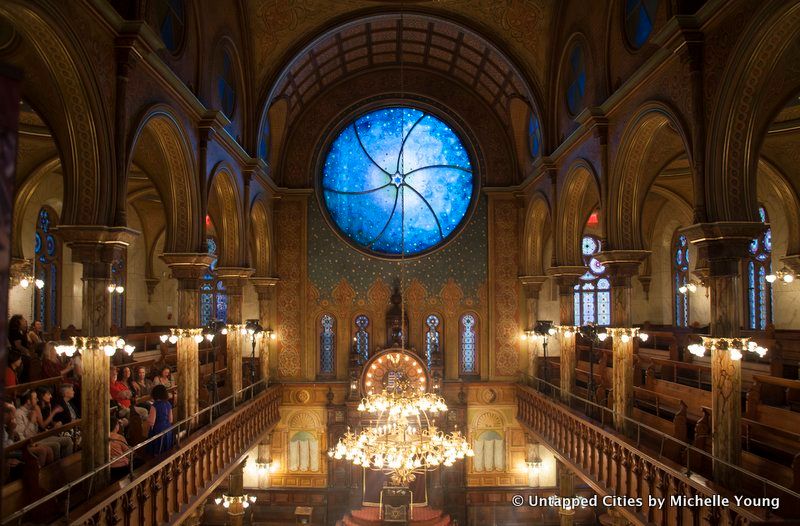
Last month, Untapped Cities partnered with the Museum at Eldridge Street to open up the landmarked Eldridge Street Synagogue for an after hour wine reception for Untapped Cities readers. Before hand, we also hosted a Secrets of the Lower East Side tour created for Untapped in partnership with the Museum, led by Rachel Serkin, Family and Education Program Associate.
Below are 10 of our favorite secrets about this stunning historical space, located in Chinatown/Lower East Side that we learned on the tour. Join us for an upcoming tour of the secrets of the synagogue:
Secrets of the Eldridge Street Synagogue After Hours Tour
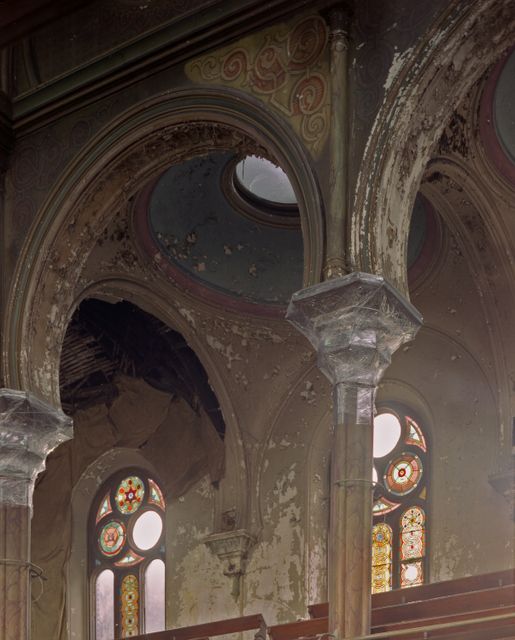
Photograph by Kate Milford from Museum at Eldridge Street
Many visitors find this dramatic fact shocking today, but for decades the main sanctuary of the Eldridge Street Synagogue sat in a state of abandonment, with nary a visitor. It was rediscovered in the 1970s, by NYU professor Gerard Wolfe who was writing his book The Synagogues of the Lower East Side. Eldridge Street was one of the spaces he desperately wanted to visit and when finally got access, this is the scene he described:
“I found the doors of the sanctuary warped shut. I pulled them open and stepped inside, and my hair stood on end. It was like the Twilight Zone, like going into the past.”
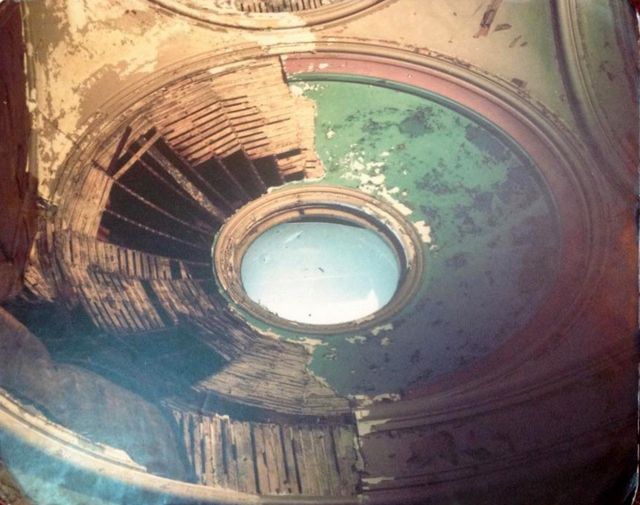
Damage to the dome. Image from Museum at Eldridge Street
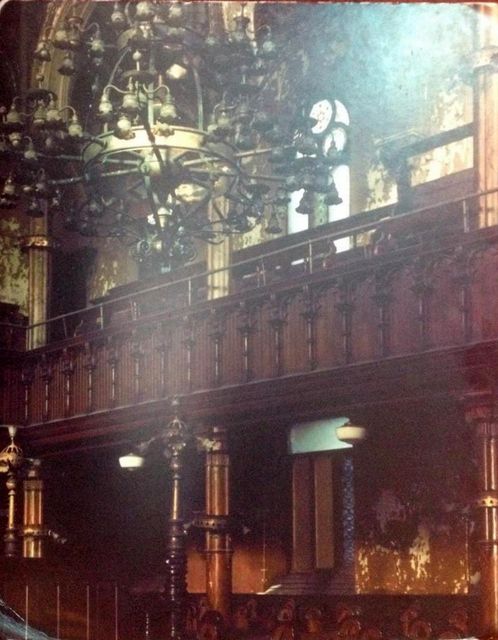
Damage to the chandelier and sanctuary. Image from Museum at Eldridge Street
The dust inside was so thick you could write in it and cobwebs hung between the pillars. There was extensive water damage to the dome, with water pouring in from the openings. Pigeons had taken roost in the balcony. Empty windows where stained glass once let in light, and fragments of walls missing. As the Museum at Eldridge Street describes in their interactive exhibition, “Prayer books and prayer shawls were scattered on benches, as if waiting for services to resume.”
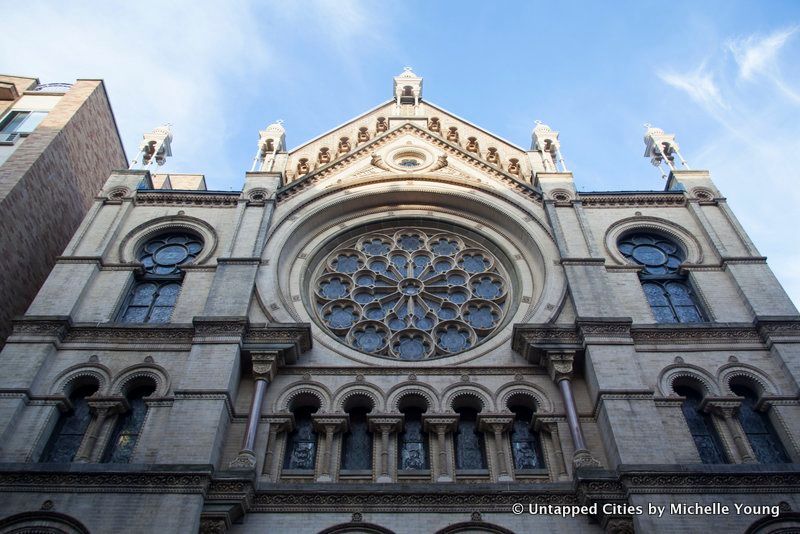
As grand as today’s Eldridge Street Synagogue is, the first locations of worship for the congregation, established in 1852, were in makeshift spaces that included an attic, below a carpenter shop, above a saloon, and even a former church. It was not until 1887 when the doors were opened to the the building on 12 Eldridge Street. According to the Museum at Eldridge Street, this was the first grand synagogue to be built by the Jewish immigrants from Eastern Europe. Today, an interactive exhibit in the downstairs sanctuary showcases the history of the congregation, the architecture of the building and its renovation.
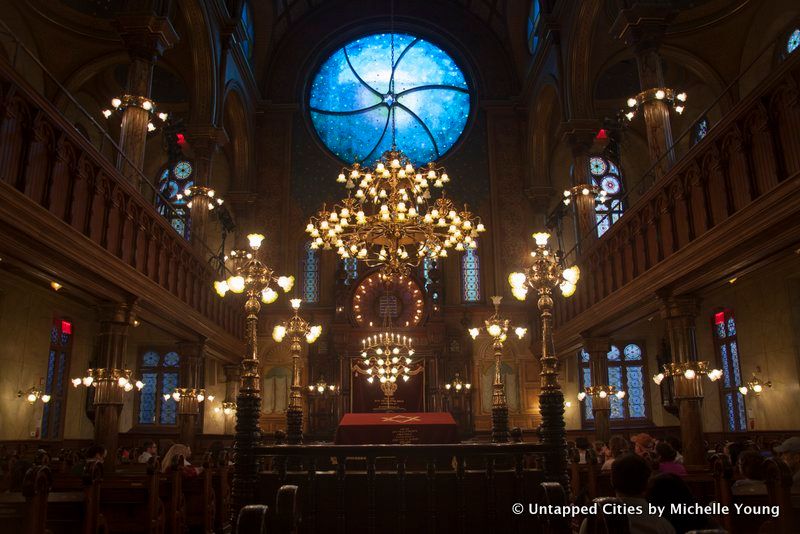
The Eldridge Street Synagogue was built quickly, in just 10 months and opened on September 4th, 1887 in time for the Jewish High Holidays. The public fascination with the building was so immense, the police department had to be called in for riot control on opening day.
Starting in the 1920s, immigration quotas were imposed Eastern Europe and other regions, and suburban flight was beginning to take place. The Eldridge Street Synagogue, a first destination for immigrants, declined in membership without the influx of new members. At some point during the 20th century, the main sanctuary was closed.
The painstaking restoration, spurred on by the Eldridge Street Project, founded by preservationist Robert Brandes Gratz, took 20 years and $18.5 million. Only in December 2007 did the doors to the main sanctuary re-open to the public. The book Beyond the Facade documents the restoration of the synagogue.
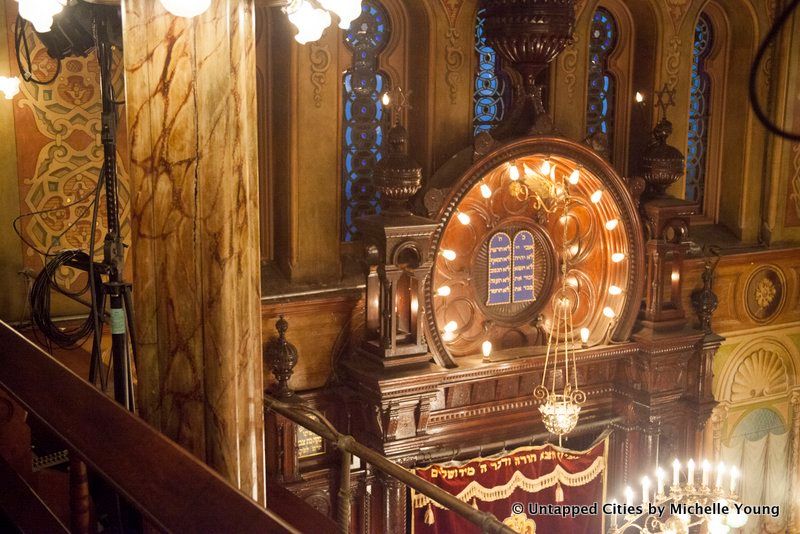
From a distance, the walls and columns of the Eldridge Street Synagogue appear to be made of fine marble. Get closer, and you realize they are actually painted to look like it. Fluted columns on the ark in the downstairs sanctuary are the same. In the front of the upstairs sanctuary, tromp l’oeils (meaning trick of the eye) on either side of the ark show a traditional curtain over the ark doors, painted to look real.
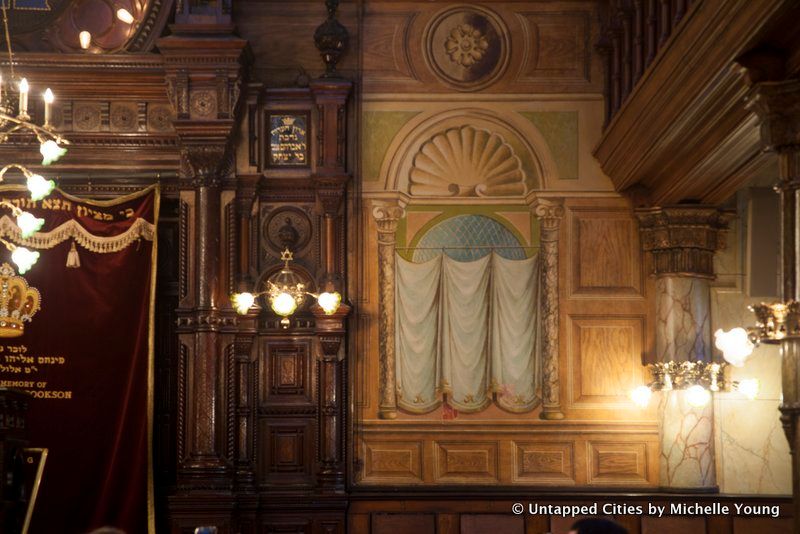
These techniques were a significant cost savings to utilizing the real thing but was still far more expensive than a simple coat of paint–all the details were applied by hand. Even for the restoration, everything was painted by hand, despite the advent of computer technology.
The choice of wood also reflects a hierarchy of materials. The ark and bimah, the sacred areas of the synagogue, are made of fine walnut. The pews are of oak, chosen for sturdiness and the floors and balcony are of pine.
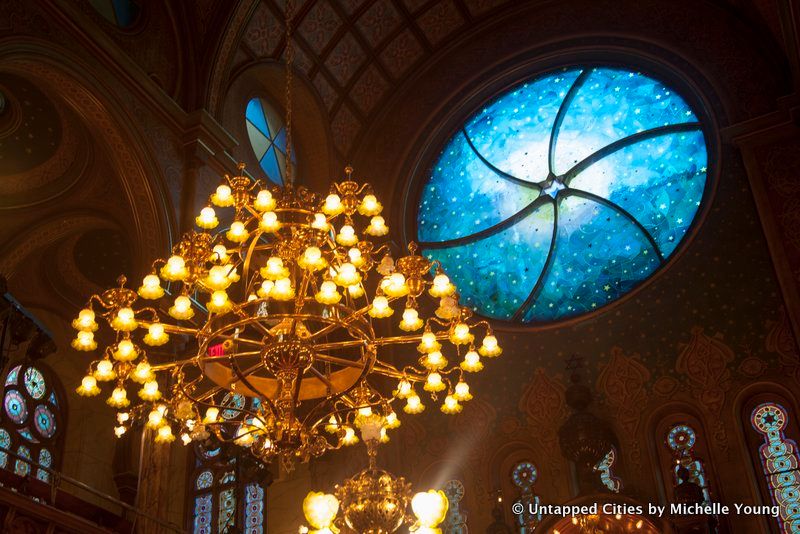
When the Eldridge Street Synagogue first opened, the lighting was powered by gas, and of course natural light from the stained glass windows. But in 1907, the fixtures were converted over to electricity. If you look at the stunning chandelier in the main sanctuary today, you’ll see that the glass bulbs face downwards. This makes sense for electrical lighting but not for gas lighting. The original configuration of this chandelier was the other way around.
You’ll also notice bare Edison-style lightbulbs throughout the sanctuary, a sign that the congregation were excited by the new technology and didn’t believe the bulbs needed any adornment, states the Museum.
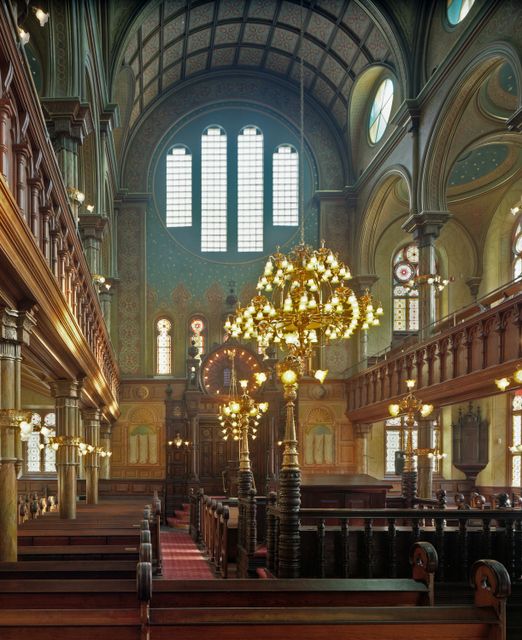
Photograph by Kate Milford from Museum at Eldridge Street
There are no photographs or blueprints that show the original stained glass window above the ark of the Eldridge Street Synagogue. In the 1940s, the window had been replaced by a four-paneled window of glass blocks (shown above), as a means of repair. A competition for the design of the stained glass window was fairly open-ended. Artist Kiki Smith and architect Deborah Gans designed a stunning piece made of 1,200 individually shaped pieces of colored glass, etched with more than 650 stars, which was installed in 2010.
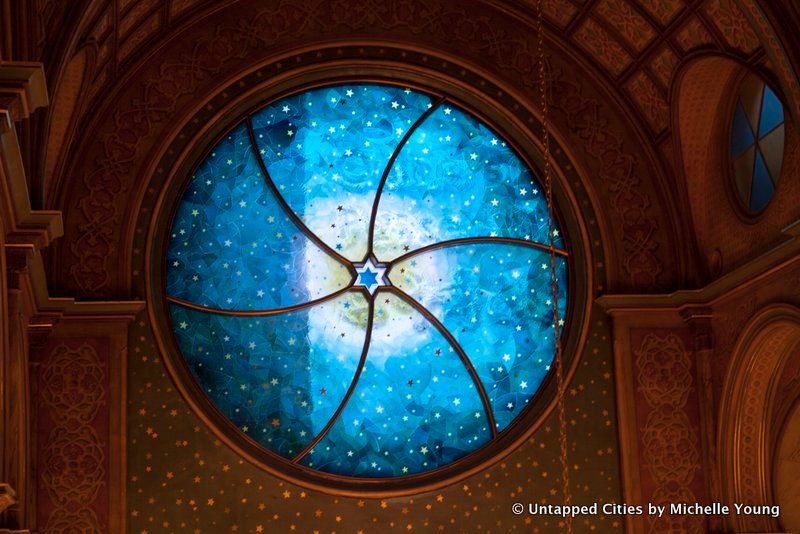
Normally, when you see stained glass there is heavy, dark colored lead cames in which stained glass pieces are slotted. Here, silicon was used instead to fuse the pieces giving it its impressive luminosity and unique design.
The glass blocks in the window now form a wall in the downstairs sanctuary, with the materials saved in keeping with the preservation principles of the Museum at Eldridge Street.
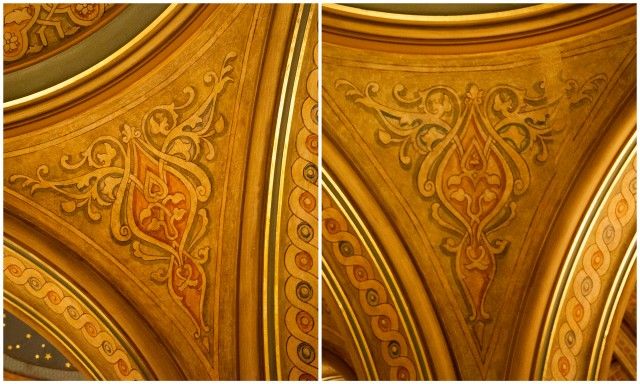
Heart on left, spade on the right. Photos by Michelle Young.
The arches supporting the domes above the balconies of the Eldridge Street Synagogue all have the same pattern, forming a spade inside the ornamentation. But one, is different. If you’re facing the front of the sanctuary, head to the balcony on the right side and look for the second dome in as you walk towards the front. Instead of a spade, one arch has a heart, “perhaps put there by a romantic artisan,” the Museum writes.
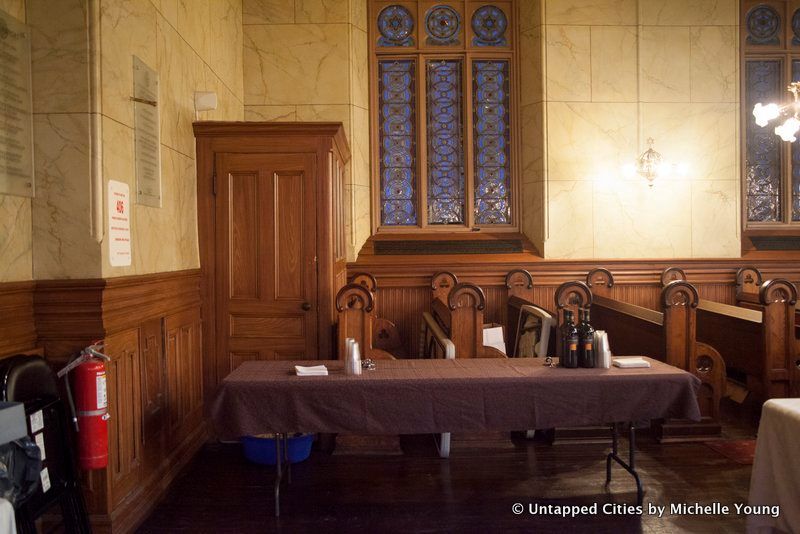
Down the original main staircase from the sanctuary and behind a door, you’ll find the original toilet of the synagogue. Today, it’s a scene worthy of a haunted house, with rusty pipes and old bricks scattered about. There’s another toilet housed in an added room in the back of the sanctuary, surrounded by wood walls. The story goes that when the Eldridge Street Synagogue was renting out the downstairs sanctuary to another congregation, the two didn’t get along. Eldridge Street decided to build their own upstairs.
The modernization the Eldridge Street Synagogue during its restoration included installing 20th and 21st century amenities, like air conditioning and an elevator, and getting the building up to code. In order to house the heating, cooling and electrical systems, a new basement had to be dug. This was done by hand to keep the building stable. Piers were replaced mostly with steel supports, going up to 18 feet below ground.
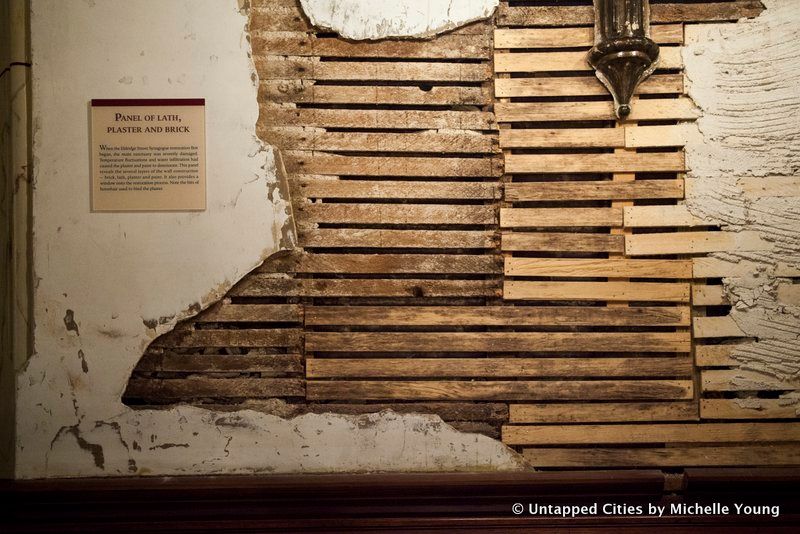
The main tenet of the restoration plans of the Eldridge Street Synagogue was to make sure the space still felt used and that history could be revealed in the architecture. As the Museum at Eldridge Street writes, “We did not want the synagogue to look like a newborn baby but rather a well-maintained and absolutely loved 120-plus-year-old building.”
Part of that history is certainly its decades of abandonment, and if you look along the left balcony of the upstairs sanctuary you will see a wall deliberately left bare. This was the state many portions of the walls were in and the museum has left a panel this way to showcase how the building was constructed, with brick, lath, plaster and paint. You can also see pieces of horsehair, that were used to bind the plaster during the restoration.
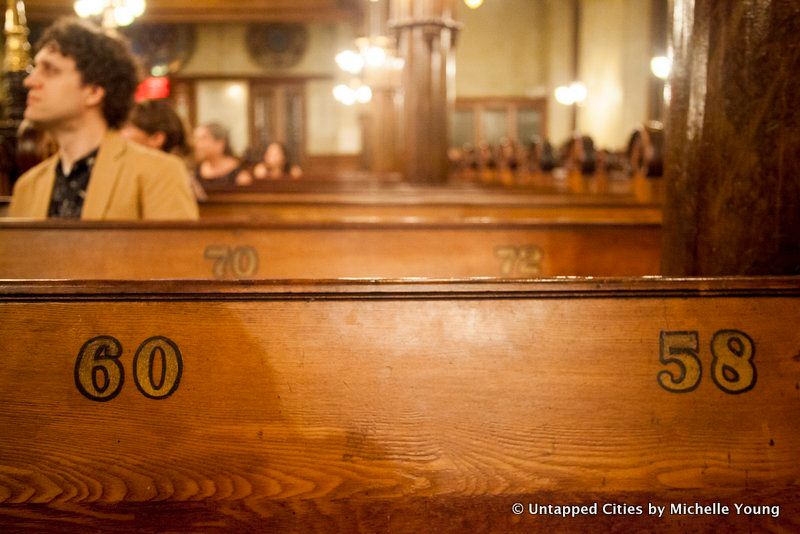
As a means to raise funds (and also prevent arguments between congregants), the Eldridge Street Synagogue sold the right to sit in numbered seats. The best seats in the house were up front, next to the ark facing the congregants. Prices ranged from a few dollars to several hundred, and a formal contract guided the exchange. You can see samples of the contracts on display in the Museum at Eldridge Street, which notes that Seat #1 was purchased in 1887 for $1,100 by Isidor Abraham, which would be about $24,100 in 2014 dollars!
Secrets of the Eldridge Street Synagogue After Hours Tour
Next, discover the Top 10 Secrets of Grand Central Terminal. Get in touch with the author @untappedmich.
Subscribe to our newsletter